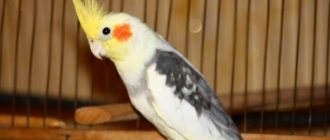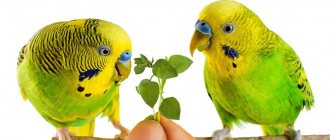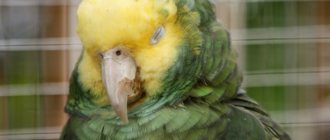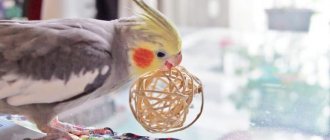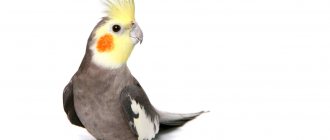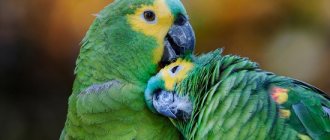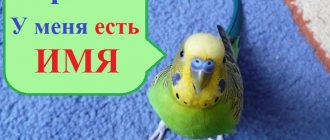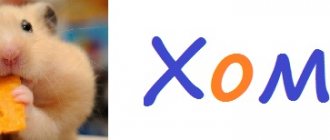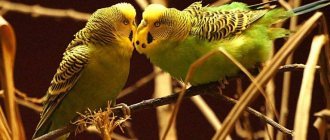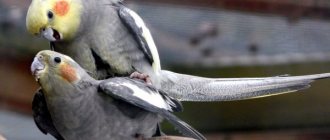The cockatiel chick grows very quickly and becomes similar to an adult parrot. Anyone who knows how to determine the age of a cockatiel can discern the external differences between them. Why is this skill so important for the buyer? Young parrots are easier to adapt and tame, so the demand for them is higher than for older individuals. To get a young bird, you can contact a trusted breeder or learn to determine the approximate age by external signs. They are common to most parrots, and there are also species characteristics that are characteristic only of cockatiels.
Description of the species
The birthplace of the species is considered to be the Australian continent, where they live in the wild. The habitat is open spaces near water resources. With abundant shrub vegetation and eucalyptus trees, where you can lay and hatch eggs, raise chicks, and where your favorite delicacies grow. The Australian parrot is distributed throughout the mainland, except for the coastal strip.
Appearance
The Corella parrot is medium-sized, slightly smaller than a pigeon. The body length is 30-35 cm, 15 of which are the tail, slightly pointed. The weight of an adult is usually from 90 to 105 grams. The egg is white. The large protruding crest and the shape of the tail are the “calling card” of this type of parrot. They love to bathe their feathers in both water and dust.
Females and males differ in color. The male has gray feathers, a yellow head, and a gray or white beak. The wings are black or dark gray with a bluish tint. Cheeks with orange or red spots. The beak is short, powerful, wide at the base with pronounced nostrils. Lutinos have an interesting light shade that needs to be looked after - bathed on time.
Females are mostly gray in color. The lower part of the body has a brown tint, and the spots on the cheeks are light brown. There are pale yellow spots on the inside of the wings. There are yellow stripes along the outer edge of the tail feathers.
The chicks are usually colored the same as the females. When they reach adult age, after about a year, the color of the plumage begins to correspond to the sex. With good care, according to the owners, reproduction is excellent at home.
The most common colors
| For some reason, the cinnamon color is formed by mixing black (melanin) and brown (pheomelanin) enzymes. The presence of a color of this color is associated with disorders in the biochemical processes of the body. A light brown color can only appear in place of a gray color. The head is brightly colored, with a gray beak. | |
| The black cockatiel is a black-gray individual with an intensely black chest. There are white spots on the wings as in the photo. Orange spots, sometimes with black splashes, are visible on the left and right sides of the head. Also with a gray beak. | |
| Albinos have red eyes against a background of completely white plumage. This feature appears in the complete absence of any pigment. Sometimes there may be a slightly creamy undertone. The head and crest are pale yellow, with a white beak. And the spots on the head correspond to a certain sex of the individual. The male is usually whiter than the female. Yellowish spots on the wings and near the tail are found in albino females, similar to marble. | |
| Lutino - according to the description, they are very similar to albinos, but the feather color is yellow with white stripes on the wings and the cheeks are orange. Lutinos also have red eyes. | |
| White - have black eyes and a white beak. This subspecies was formed by crossing gray males with white females. Birds have an intense yellow coating. The male has two long white feathers in the tail, the undertail is lighter. In the female, the color of the feathers under the tail has a clear marble pattern, and the tail itself is yellow. | |
| Sheki - with gray feathers, with patchy white spots on them. Those birds that have white and gray colors in equal quantities, and whose spots are symmetrical and clear, are valuable. This type of bird is the most successful for obtaining new subspecies. They have orange cheeks like lutino. | |
| Harlequin is a variety of Shek. An individual with gray wings, a yellow head and a crest, the same orange cheeks as the lutino. Everything else is white | |
| Light gray is the result of crossing black-eyed nymphs of white and gray colors. Much lighter than the usual gray individual. The rest of the characteristic features remained the same. | |
| Whitewings are a light gray parrot with white wing feathers. The remaining characteristics of the gray nymph are preserved. | |
| The gray pearl is the result of crossing a bird of the dark yellow and brown subspecies. The edge of the feather is dark, the middle is white. Sometimes yellow individuals with a hint of cinnamon are formed. The intensity of gray color may vary. | |
| The black-winged parrot is colored light gray, the back, wings, and tail are darker. The beak is also usually gray. Individuals of both sexes are the same in color and have distinct whitish spots on the wings. |
Sorry, there are no surveys available at this time.
Common signs for all parrots
Parrots of any species have a certain set of characteristics that suggest how many years the bird has lived. These are, first of all, external indicators:
- development of the skeleton and limbs;
- body size and weight;
- plumage.
In addition, chicks can be recognized by their voice timbre and speech abilities. Let's look at each of the features in a little more detail.
Voice
Young parrots do not know how to sing fully. They make various sounds, chirp stupidly, and try to imitate their older comrades. After some time, orderly bird “speech” appears, and by the onset of the mating season, the males begin to show themselves, performing intricate melodies. Each species of parrot has its own age. For example, cockatiels are ready to reproduce from nine months. In addition to mating songs, birds exhibit the ability to learn and perceive human speech.
Bone structure
This sign continues the theme of sexual maturity, but applies more to females than to males. Growing cockatiels of both sexes are similar in that they sit upright on their perches and their paws are close to each other. An adult female, sitting on a perch, spreads her legs wide and bends over. This means that her pelvic bones have spread enough and she is ready to lay eggs.
On a note! You can distinguish young birds from adult birds by the rigidity of their keels. The chicks have a fragile, graceful sternum. Mature parrots have a prominent, hard keel.
Limb development
The chick's paws are covered with delicate pink skin. The soles are smooth, without growths and corns. As the bird grows up, small scales appear on its paws, tightly adjacent to each other. The older the parrot, the coarser these scales are, the more intensely they flake. Although this indicator may also apply to a sick bird. Separation of the skin occurs with certain diseases, for example, knemidocoptosis.
Body size
Bird offspring grow quite quickly and after a few months reach the size of adults. If we know the average parameters of a given type of parrot, we can approximately determine the age of a particular bird. When deviating downward from the average body weight and size, it is obvious that this is a chick.
Note! A small, light parrot may turn out to be an adult. This happens if they try to sell a sick, emaciated individual that was poorly fed and kept locked up.
Plumage
Parrots of reproductive age have smooth, dense, well-groomed plumage. It becomes this way as a result of the bird’s constant concern for its appearance. Young parrots do not know how to properly care for their feathers, rearrange them one by one and smooth them. In addition, their juvenile molt may be prolonged, during which infant feathers are replaced by new, strong feathers. It should be noted that parrots molt at any age, and more intensely during illness.
Another indicator of age is a certain sloppiness of the bird. Inexperienced chicks may have their feathers stained with droppings. The color of the plumage is dull and unstable.
Reproduction
First of all, in order for cockatiel breeding to be successful, a nesting house is built. Dimensions vary from 200 x 200 x 380 mm to 300 x 300 x 350 mm. It is better not to make a large box; an egg or chick may get lost in it and freeze. Although Corellas reproduce well in captivity, this process is not simple and without special training for the pet, the percentage of the bird laying and hatching eggs is small.
For breeding, you need to choose birds that are not thin and not very well-fed. It is better if the female is about two years old, and the partner is one and a half years old.
If the female is younger, she will not withstand the load and will die. And males under one and a half years old are not responsible and will not fulfill their duties in heating the eggs and feeding the offspring. This could jeopardize the entire process. The female will have to take care of the eggs, she will become very exhausted and may also fall.
In nature, the signal for Corellas to start breeding is the length of daylight hours. In order for the female to lay offspring, over the course of 5-6 weeks it is necessary to gradually increase the duration of illumination, adding 8-10 minutes per day, gradually reaching 16-18 hours of daylight. If preparation for reproduction occurs in winter or autumn, it is worth using lighting.
To stimulate reproductive function, the diet must be properly balanced with protein and plant foods, as well as your favorite treats. If the male begins to sing frequently and intensely, it means he is ripe for fertilization. When the female lays the first egg, the male sits on the eggs and begins the incubation process. Usually there are 3-5 eggs in a clutch, but under favorable conditions there have been cases when a bird can lay 7-8 eggs. The chicks are born after 22 days.
Home care
The crested parrot is not whimsical. The content is not complicated, but like any living creature, it requires attention and care. As reviews say, pets tolerate living in cages well. It is better if it is 1.5 square meters in size. It can be equipped with ladders and poles made from natural tree branches, ideally some kind of fruit tree.
A drinking bowl, feeder, and bath are also necessary. Care is based on constant feeding, cleanliness, health care, and bathing.
During the first days in the house, the winged guest should not be disturbed again. You need to let the bird get used to it. Then you can slowly start talking, approaching the cage without sudden movements, so that he gets used to the voice and the owner. The bird is very friendly and should quickly begin to show interest and communication.
The Australian lutino parrot is one of the most capable of spoken species. For some reason, he is better at imitating not only voices, but also mechanical sounds. For example, it creaks, clangs, knocks like a hammer or clicks. He reproduces whatever he wants.
Diet
Birds are not picky about food; they eat a lot of things. Cockatiels are fed mainly cereal mixtures. Their favorite treat:
- corn;
- sunflower seeds (not fried);
- oats;
- rape;
- forbs;
- flax seed;
- sesame;
- wheat;
- millet.
Don't forget to eat protein food at least once a week. Favorite delicacy is mealworms. It would be nice to teach him vegetables and fruits. According to reviews, it is strictly forbidden to feed the bird with delicacies from the table. What a person consumes will only harm the bird, so feeding Cockatiels should be balanced.
Bathing
Bathing is very important during the grooming process. The bird will be happy to bathe itself; this is its favorite pastime. You can give water in a special bathtub, not deep. Make sure there is no draft. Do not use detergents or blow dry. It is better not to use anything else except a paper towel for cleaning.
You need to be careful with lutino. You can bathe him under the tap. Or spray with a spray bottle, this is also considered bathing. It is strictly forbidden to bathe chicks. For some reason, many breeders prefer Corella. The bird will quickly integrate into the home environment and, of course, will occupy a special place in the house and become everyone’s favorite.
Feeding
The Corella parrot is not a gourmet, preferring any particular type of food. On the contrary, as in the case of budgies, he will easily eat grains and grain mixtures offered to him. It will not be superfluous, from time to time, to offer them fresh fruits and berries, which his wild relatives love so much.
And remember, as with any pet bird, you need to spend as much time as possible with cockatiels socializing and simply feeding them. Thanks to these simple rules, the birds will not only adapt to their new home as quickly as possible, but will also consider themselves full members of your family. Toys hung inside the cage will not be superfluous. Cockatiels love toys and spend a lot of time with them, especially when you are not around.
Video “Corella bathes”
A funny video showing how to bathe a parrot.
Was this article helpful?
Thank you for your opinion!
The article was useful. Please share the information with your friends.
Yes
No
X
Please write what is wrong and leave recommendations on the article
Cancel reply
Rate the benefit of the article: Rate the author ( 8 votes, average: 4.00 out of 5)
Discuss the article:
